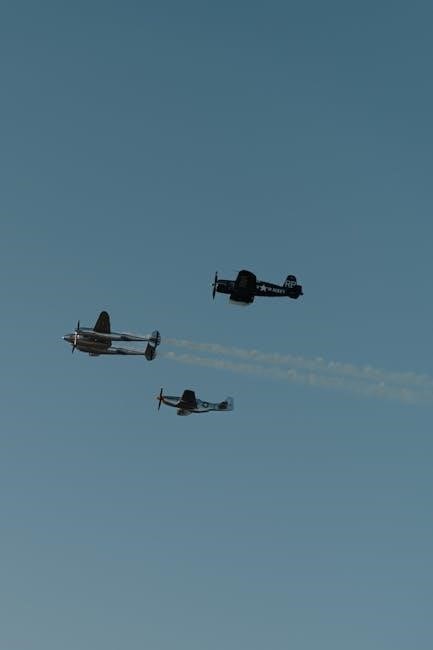World War II aircraft were diverse‚ serving roles from combat to reconnaissance. Famous planes like the Supermarine Spitfire and Mitsubishi A6M Zero showcased innovation. Detailed manuals and specifications highlight their historical significance‚ revealing technical advancements and strategic impacts on the war.
1.1 Overview of WWII Aviation
World War II aviation was marked by rapid technological advancements and diverse aircraft designs. From iconic fighters like the Supermarine Spitfire to strategic bombers such as the Boeing B-29 Superfortress‚ aircraft played pivotal roles in combat‚ reconnaissance‚ and logistics. Detailed manuals and specifications reveal the complexity of these machines‚ showcasing their speed‚ maneuverability‚ and firepower. The era saw the rise of carrier-based fighters‚ ground attack planes‚ and long-range bombers‚ each tailored for specific missions. These aircraft not only shaped the war’s outcome but also laid the foundation for modern aviation.
1.2 Importance of Aircraft in WWII
Aircraft played a pivotal role in WWII‚ revolutionizing warfare by enabling air superiority‚ strategic bombing‚ and rapid logistics. Planes like the B-29 Superfortress and P-51 Mustang demonstrated their importance in long-range missions and escort duties. The ability to dominate skies shifted battle outcomes‚ while technological advancements in design and weaponry set the stage for modern aviation. Aircraft were indispensable in reconnaissance‚ ground support‚ and naval operations‚ making them a cornerstone of WWII strategy and a key factor in determining the war’s outcome.
1.3 Major Categories of WWII Aircraft
WWII aircraft were categorized into fighters‚ bombers‚ reconnaissance‚ and ground attack planes. Fighters like the Supermarine Spitfire excelled in dogfights‚ while bombers such as the Boeing B-29 delivered massive payloads. Reconnaissance aircraft gathered crucial intel‚ and ground attack planes like the Junkers Ju 87 Stuka supported troops. Each category played a vital role in shaping air combat strategies‚ ensuring air superiority‚ and influencing the war’s progression. These classifications highlight the diverse roles aircraft fulfilled during the conflict.
Famous Allied Aircraft
Allied forces relied on iconic aircraft like the Supermarine Spitfire‚ P-51 Mustang‚ and B-29 Superfortress. These planes played pivotal roles in securing air superiority and executing strategic missions.
2.1 Supermarine Spitfire
The Supermarine Spitfire was a iconic British fighter aircraft that played a crucial role in World War II. Known for its sleek design and Rolls-Royce Merlin engine‚ it excelled in air-to-air combat. The Spitfire’s agility and firepower made it a favorite among Allied pilots. It was instrumental in the Battle of Britain‚ defending against Luftwaffe attacks. Over time‚ the Spitfire evolved through multiple variants‚ each improving performance and armament. Its legacy endures as a symbol of British resilience and innovation during the war.
2.2 North American P-51 Mustang
The North American P-51 Mustang was a legendary long-range fighter aircraft that significantly impacted World War II. Designed for escort missions‚ it boasted exceptional speed‚ range‚ and durability. Powered by a Packard V-1650 Merlin engine‚ the Mustang could fly deep into enemy territory‚ protecting bombers and engaging enemy fighters. Its six .50-caliber machine guns and streamlined design made it a formidable opponent. The P-51 played a pivotal role in gaining air superiority‚ particularly in the European and Pacific theaters‚ and remains one of the most celebrated aircraft in military history.
2.3 Boeing B-29 Superfortress
The Boeing B-29 Superfortress was a revolutionary strategic bomber that played a pivotal role in World War II. Known for its advanced design‚ the B-29 featured a pressurized cabin‚ remote-controlled gun turrets‚ and a range of over 5‚000 miles. It was the largest production aircraft of the war and carried a heavy payload‚ making it instrumental in long-range bombing campaigns. The B-29 is famously associated with the atomic bombings of Hiroshima and Nagasaki‚ marking the end of WWII. Its technological innovations set the standard for post-war bombers.
2.4 Grumman F4F Wildcat
The Grumman F4F Wildcat was a carrier-based fighter aircraft that served as the U.S. Navy’s front-line fighter during the early years of World War II. Though not as fast or maneuverable as the Japanese Zero‚ the Wildcat’s durability and ability to withstand significant damage made it highly effective. It played a crucial role in the Pacific Theater‚ particularly during the Battle of Midway. The Wildcat’s robust design and strategic importance made it a key asset for Allied forces‚ supporting ground operations and air defense until more advanced fighters became available.
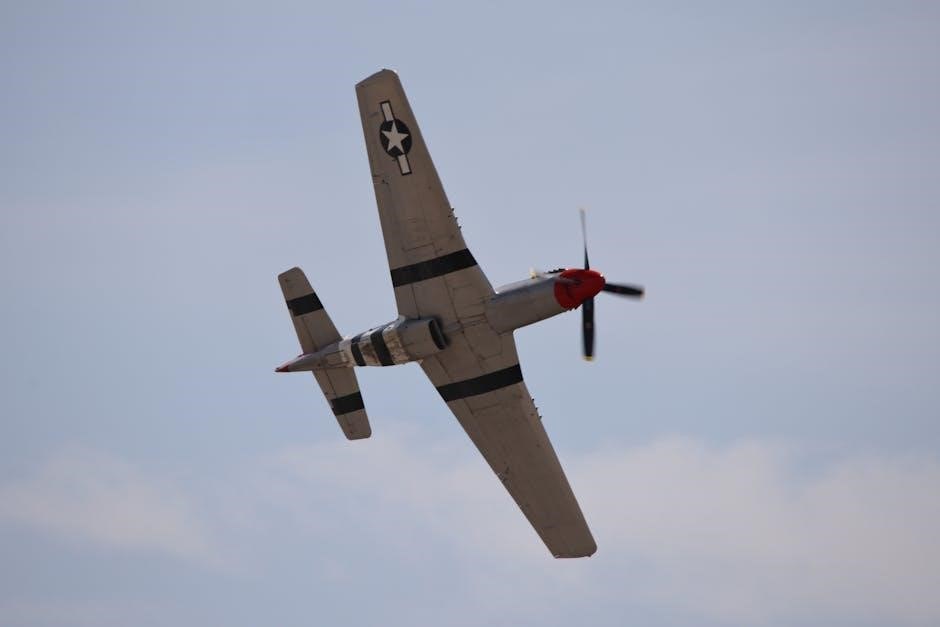
Axis Powers’ Aircraft
Axis powers‚ including Germany and Japan‚ developed iconic aircraft like the Mitsubishi A6M Zero and Messerschmitt Bf 109. These planes played pivotal roles in air superiority and strategic missions‚ showcasing advanced engineering and tactical versatility during World War II.
3.1 Mitsubishi A6M Zero
The Mitsubishi A6M Zero was a lightweight‚ highly maneuverable Japanese fighter aircraft. Known for its exceptional range and agility‚ it dominated early Pacific Theater skies. Its design emphasized speed and endurance‚ making it a formidable opponent. However‚ its lightweight construction made it vulnerable in dogfights and against better-armored Allied planes. The Zero played a crucial role in Japanese operations‚ including the attack on Pearl Harbor‚ but its weaknesses became apparent as Allied forces developed counter-strategies.
3.2 Messerschmitt Bf 109
The Messerschmitt Bf 109 was a cornerstone of the Luftwaffe‚ serving as a primary fighter throughout World War II. Its sleek design and advanced aerodynamics made it highly effective in dogfighting and interception roles. Produced in large numbers‚ the Bf 109 saw action in multiple theaters‚ from the Battle of Britain to the Eastern Front. Variants like the Bf 109F introduced improvements‚ enhancing its combat performance. Despite its strengths‚ the Bf 109 faced challenges against evolving Allied aircraft‚ yet it remains one of the most iconic and influential fighters of the war.
3.3 Junkers Ju 87 Stuka
The Junkers Ju 87 Stuka was a German dive bomber renowned for its precision and psychological impact during World War II. Its distinctive siren‚ known as the “Jericho trumpet‚” was designed to intimidate enemy forces. The Stuka excelled in ground attack missions‚ playing a key role in the Blitzkrieg tactics during the early war years. However‚ its slow speed and vulnerability to enemy fighters made it less effective in later stages of the conflict. Despite this‚ the Stuka remained a symbol of German air power and tactical innovation.
3.4 Focke-Wulf Fw 190
The Focke-Wulf Fw 190 was a highly advanced German fighter aircraft during World War II‚ designed by Kurt Tank. Known for its exceptional speed‚ maneuverability‚ and firepower‚ it became one of the most formidable fighters of the war. Initially‚ it outperformed Allied planes like the Spitfire‚ forcing the Allies to adapt their tactics. The Fw 190 excelled in both air-to-air combat and ground attack roles. However‚ its production was hampered by resource shortages‚ and later models faced engine reliability issues. Despite these challenges‚ the Fw 190 remained a key asset for the Luftwaffe.
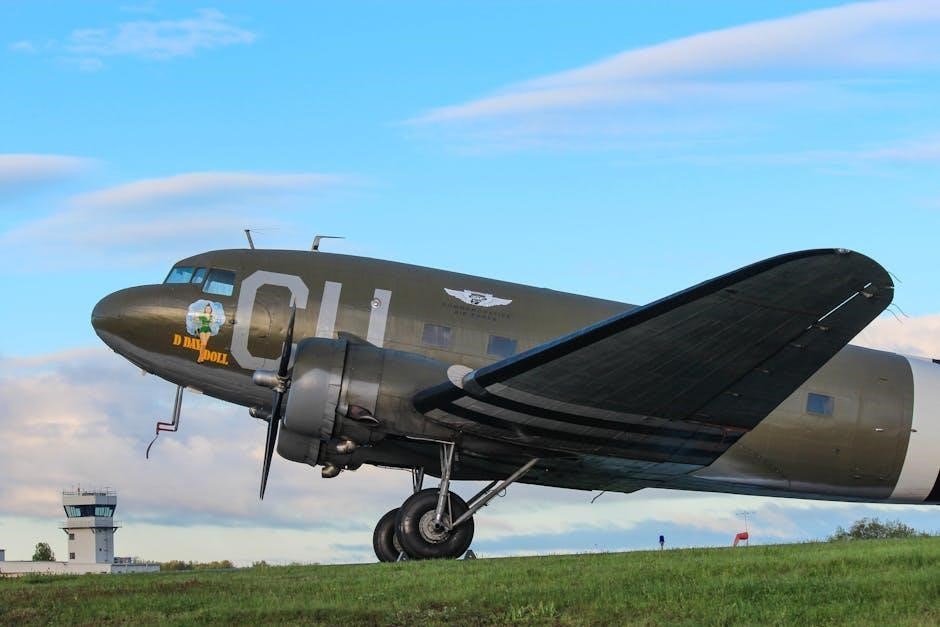
Aircraft Roles and Specializations
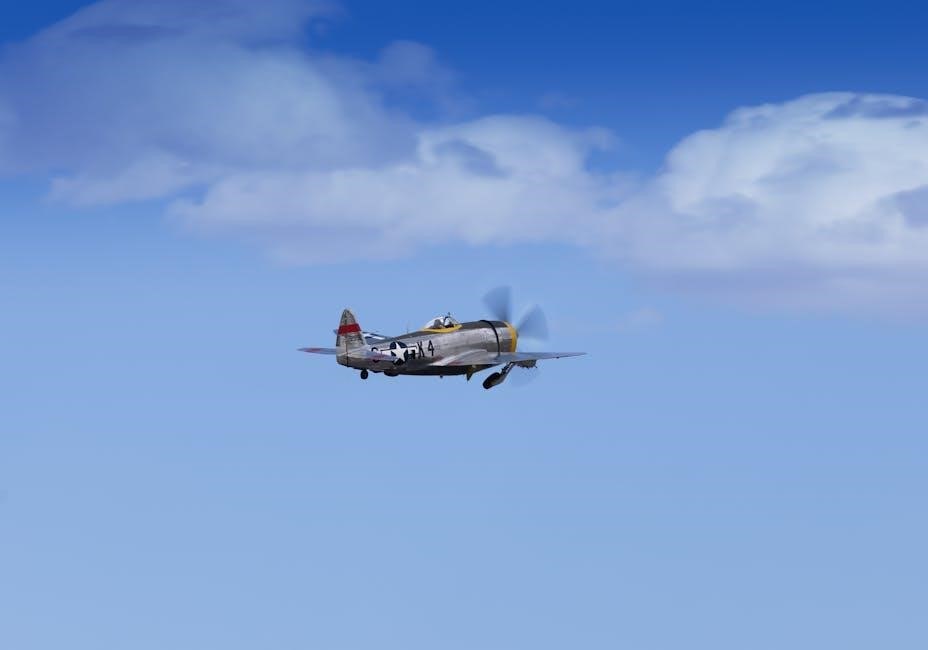
WWII aircraft were specialized for specific missions‚ including combat‚ reconnaissance‚ and ground attack. Each role required unique designs‚ optimizing performance for tasks like dogfighting or strategic bombing.
4.1 Fighter Aircraft
Fighter aircraft were crucial in WWII‚ designed for air-to-air combat and gaining air superiority. Planes like the Supermarine Spitfire and Mitsubishi A6M Zero excelled in dogfighting. Their agility‚ speed‚ and firepower made them essential for defending airspace and escorting bombers. Durability and maneuverability were key features‚ with designs often evolving to counter enemy advancements. These aircraft played a pivotal role in determining the outcome of battles‚ showcasing technological innovation and strategic importance in aerial warfare during the conflict.
4.2 Bomber Aircraft
Bomber aircraft were pivotal in WWII‚ designed to deliver explosives over enemy territories. Strategic bombers like the Boeing B-29 Superfortress and Avro Lancaster conducted long-range missions‚ while dive bombers such as the Junkers Ju 87 Stuka targeted ground forces. Torpedo bombers like the Grumman TBF Avenger attacked naval vessels. These planes played a crucial role in weakening enemy infrastructure and morale‚ with advancements in payload capacity and precision shaping their effectiveness. Their strategic impact was significant‚ influencing the war’s outcome through campaigns like the atomic bombings.
4.3 Reconnaissance Aircraft
Reconnaissance aircraft played a vital role in WWII‚ providing crucial intelligence through aerial photography and radar. Planes like the Supermarine Spitfire and de Havilland Mosquito were adapted for high-altitude missions‚ capturing detailed images of enemy positions. These aircraft operated stealthily‚ often unarmed‚ relying on speed and altitude for protection. Their missions significantly influenced strategic decisions‚ making them indispensable assets in the war effort.
4.4 Ground Attack Aircraft
Ground attack aircraft were specifically designed to support ground forces by targeting enemy troops‚ tanks‚ and fortifications. Planes like the Junkers Ju 87 Stuka and Ilyushin Il-2 Sturmovik excelled in this role‚ employing dive-bombing tactics and heavy armament. These aircraft were crucial in close air support missions‚ providing direct firepower to advancing troops. Their durability and ability to carry substantial payloads made them indispensable in both European and Pacific theaters‚ significantly influencing the outcome of ground operations during WWII.
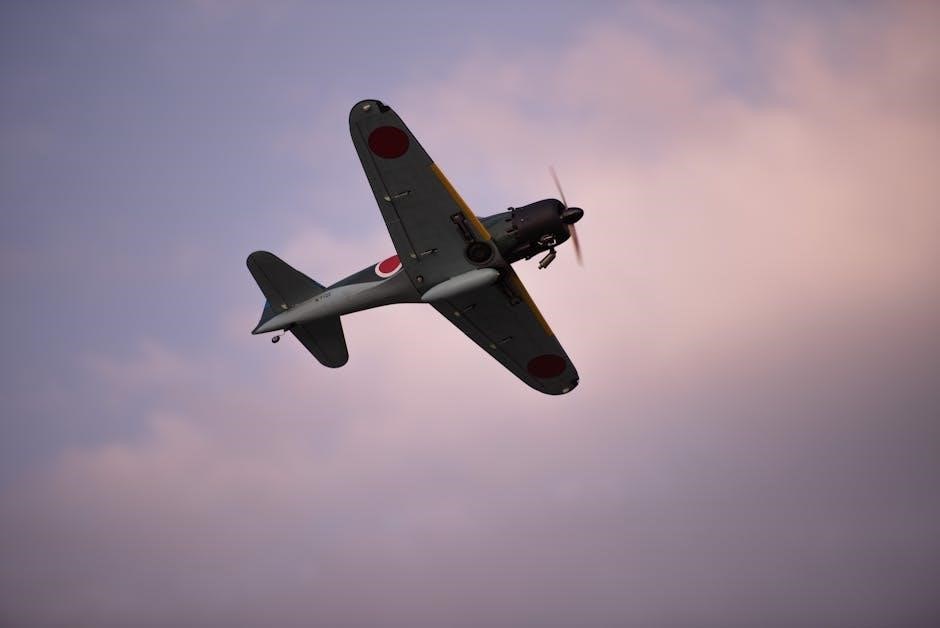
Technological Innovations
WWII saw significant advancements in aviation technology‚ including radar systems‚ jet engines‚ and improved armor. These innovations enhanced aircraft performance‚ durability‚ and combat effectiveness‚ shaping modern aviation.
5.1 Radar Technology
Radar technology played a pivotal role in WWII‚ revolutionizing air defense and interception. Britain’s development of ground-based radar systems enabled early detection of enemy aircraft‚ crucial for the Battle of Britain. This innovation allowed for better coordination of air defenses‚ improving response times and accuracy. Radar also enhanced night fighting capabilities and navigation‚ giving Allied forces a strategic advantage. Its widespread adoption marked a significant leap in aviation technology‚ influencing both tactics and aircraft design during the war.
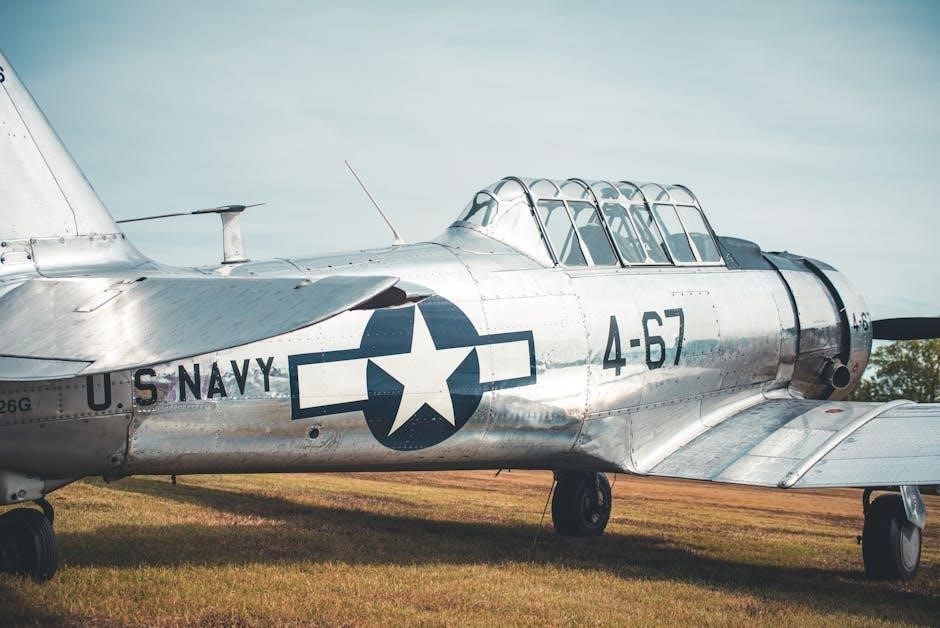
5.2 Jet Engines
The introduction of jet engines during WWII marked a revolutionary leap in aviation technology. The first operational jet fighters‚ such as the Messerschmitt Me 262 and Gloster Meteor‚ demonstrated unprecedented speed and altitude capabilities. Jet engines eliminated the need for propellers‚ reducing drag and enabling faster aircraft. However‚ early jets faced challenges like limited range and reliability issues. Despite these limitations‚ their deployment hinted at a future dominated by jet-powered aircraft‚ forever changing the landscape of air combat and civilian aviation post-war.
5.3 Armor and Defensive Systems
WWII aircraft incorporated advanced armor and defensive systems to enhance survivability. Armor plating protected critical areas like cockpits and engines‚ while self-sealing fuel tanks reduced vulnerability to fire. Some planes‚ like the Grumman F4F Wildcat‚ featured durable designs that withstood significant damage. Defensive armaments‚ such as rear gun turrets on bombers‚ provided additional protection. These innovations were crucial in improving aircraft resilience‚ allowing them to endure intense combat conditions and maintain operational effectiveness throughout the war.
5.4 Navigation and Communication
WWII aircraft relied on rudimentary yet effective navigation and communication systems. Early planes used compasses‚ maps‚ and celestial navigation‚ while later models incorporated radio communication for coordination. Radar technology emerged‚ enhancing navigation and enemy detection. These advancements improved mission accuracy and teamwork‚ despite initial limitations in range and reliability. Effective communication systems were vital for strategic operations‚ ensuring pilots could adapt to dynamic battle scenarios and maintain tactical advantage.
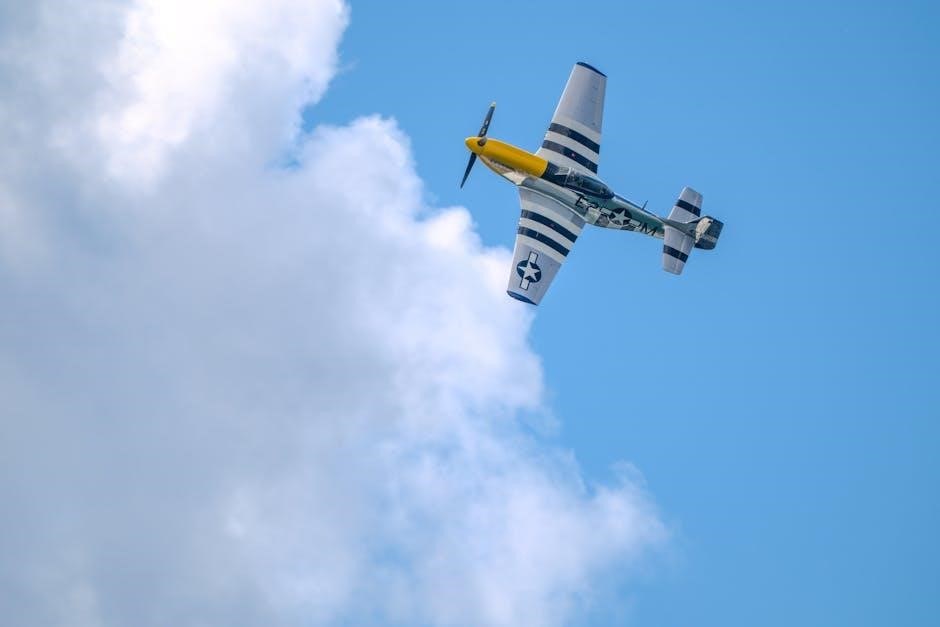
Aircraft Specifications and Performance
WWII aircraft specifications varied widely‚ with speed‚ range‚ and armament tailored to specific roles. Performance metrics like maneuverability and durability were critical for combat effectiveness and survival.
6.1 Speed and Maneuverability
Speed and maneuverability were critical for WWII aircraft‚ determining their effectiveness in dogfights and evasion. Fighters like the Supermarine Spitfire and Mitsubishi A6M Zero excelled in agility‚ while the Messerschmitt Bf 109 and North American P-51 Mustang showcased superior speed. Engine power‚ aerodynamic design‚ and lightweight materials contributed to these performance metrics. These advancements allowed aircraft to outperform opponents‚ making them indispensable in air combat scenarios during the war.
6.2 Range and Endurance
Range and endurance were vital for WWII aircraft‚ enabling long-range missions and prolonged operations. Bombers like the Boeing B-29 Superfortress could fly thousands of miles‚ while fighters such as the P-51 Mustang used drop tanks to extend their range. These capabilities allowed aircraft to support ground forces‚ conduct strategic bombing‚ and patrol vast areas. Enhanced fuel capacity and efficient engine designs were key to achieving these performance metrics‚ making range and endurance critical factors in air campaign success during the war.
6.3 Armament and Firepower
WWII aircraft featured varying armament to suit their roles‚ from machine guns and cannons in fighters to heavy payloads in bombers. Fighters like the Supermarine Spitfire and Messerschmitt Bf 109 were equipped with machine guns and cannons for dogfighting. Bombers such as the Boeing B-29 Superfortress carried massive explosive payloads‚ while ground attack aircraft like the Junkers Ju 87 Stuka used bombs and rockets. The Grumman F4F Wildcat‚ though outmatched in speed‚ could sustain damage and deliver effective firepower. Armament varied by aircraft type and mission‚ reflecting the diverse tactical needs of the war.
6.4 Durability and Maintenance
WWII aircraft durability varied‚ with designs emphasizing survival in combat. Planes like the Grumman F4F Wildcat could sustain significant damage and remain operational. Maintenance was critical‚ with detailed manuals guiding repairs. Ground crews worked tirelessly to keep aircraft airworthy‚ often under challenging conditions. Durable materials and redundant systems enhanced survivability‚ while regular maintenance ensured readiness. The ability to withstand damage and rapid repairs were key to sustaining air campaigns‚ making durability and maintenance vital factors in the war’s outcome.
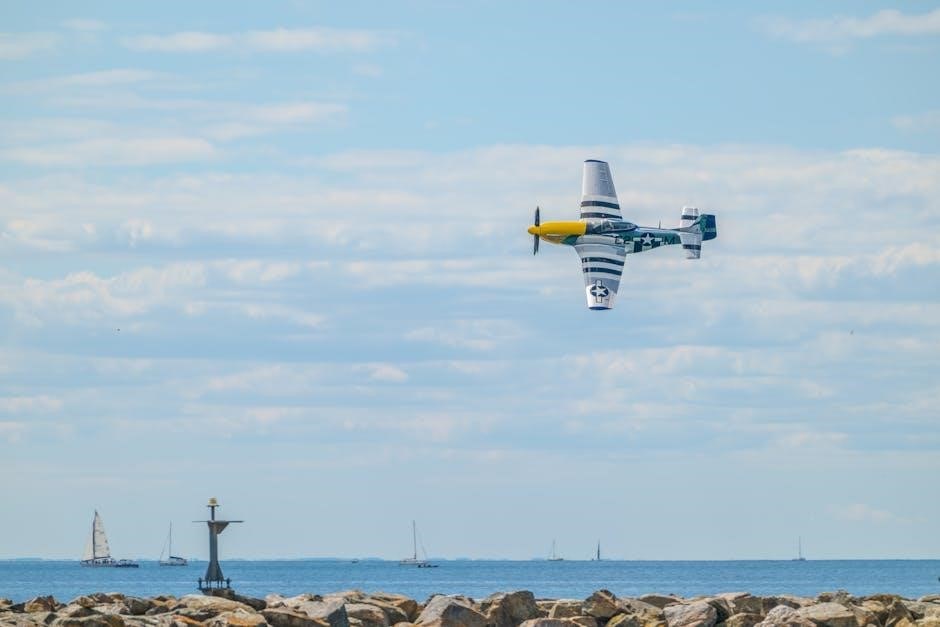
Notable Battles and Operations
WWII saw pivotal air battles like the Battle of Britain and Pacific Theater campaigns. Strategic bombing and air support were crucial‚ shaping the war’s outcome significantly.
7.1 Battle of Britain
The Battle of Britain‚ fought between the RAF and Luftwaffe in 1940‚ was a pivotal air campaign. Radar technology gave the British early warnings‚ enabling effective defense. Supermarine Spitfires and Hurricanes played crucial roles‚ countering German bombers and fighters. The battle marked the first major defeat of Nazi forces‚ showcasing the importance of air superiority. It highlighted the strategic use of radar and the resilience of British forces‚ setting the tone for future Allied operations in WWII.
7.2 Pacific Theater Air Campaigns
The Pacific Theater air campaigns were marked by intense dogfights and strategic bombing missions. The Grumman F4F Wildcat and Boeing B-29 Superfortress played pivotal roles. Carrier-based aircraft like the Wildcat were crucial in naval battles‚ while the B-29 conducted long-range bombing raids. These campaigns highlighted the importance of air superiority and logistics‚ with the Allies gradually gaining control of the skies. The P-51 Mustang also excelled in escorting bombers‚ ensuring the success of deep-penetration missions. These efforts were vital in securing key islands and ultimately leading to Allied victory in the Pacific.
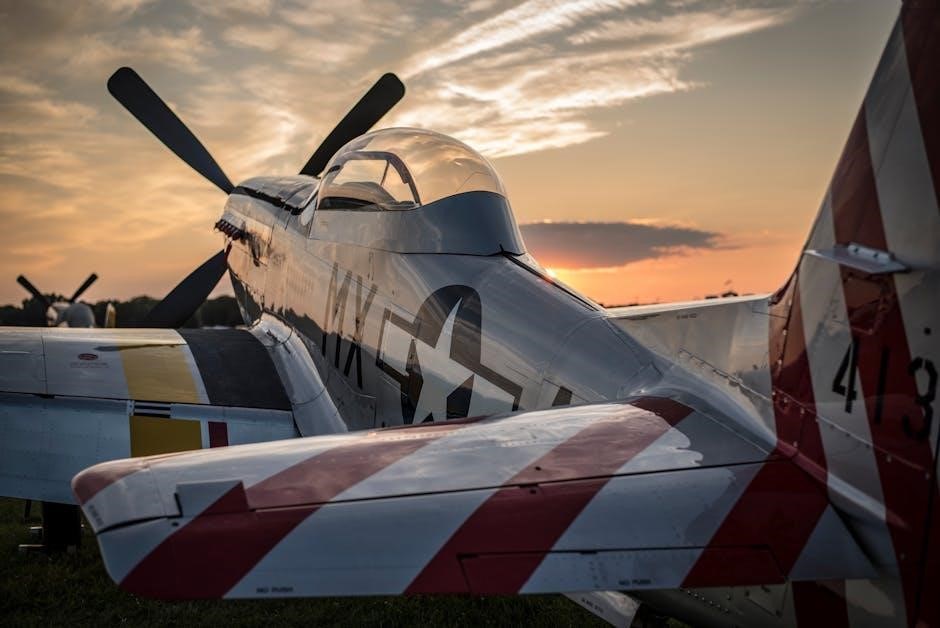
7.3 Strategic Bombing Campaigns
Strategic bombing campaigns in WWII targeted industrial and military sites to weaken enemy capabilities. The Boeing B-29 Superfortress played a pivotal role‚ conducting high-altitude missions and delivering atomic bombs. These campaigns disrupted supply chains and morale‚ particularly in Japan and Germany. Firebombing cities like Dresden and Tokyo caused widespread destruction‚ while precision raids focused on key facilities. The B-29’s range and payload capacity made it a cornerstone of Allied strategic bombing efforts‚ significantly impacting the war’s outcome and setting the stage for modern airpower strategies.
7.4 Air Support in Ground Operations
Air support in ground operations revolutionized WWII tactics‚ enabling direct assistance to troops. Aircraft like the Grumman F4F Wildcat and Junkers Ju 87 Stuka provided crucial close air support‚ destroying enemy positions and boosting morale. Ground-attack planes targeted tanks‚ bunkers‚ and troop concentrations‚ while reconnaissance aircraft gathered vital battlefield intelligence. This integration of air and ground forces enhanced operational efficiency‚ allowing for coordinated assaults and rapid responses to enemy movements‚ ultimately shaping the outcome of key battles and campaigns across all theaters of the war.
Impact of Aircraft on WWII Outcomes
Aircraft decisively influenced WWII outcomes by enabling air superiority‚ strategic bombing‚ and logistical support. They disrupted enemy supply lines‚ boosted morale‚ and shifted battlefield dynamics‚ accelerating Allied victories.
8.1 Air Superiority and Control
Air superiority was crucial in WWII‚ allowing forces to dominate skies and protect ground operations. Radar systems enabled early detection of enemy planes‚ while interceptors like the Spitfire and Bf 109 excelled in dogfighting. The ability to control airspace determined battle outcomes‚ with Allied forces eventually gaining the upper hand through superior numbers and technology. This dominance allowed for effective strategic bombing and ground support‚ shifting the war’s momentum decisively in their favor.
8.2 Strategic Bombing and Morale
Strategic bombing campaigns in WWII targeted industrial centers‚ disrupting enemy production and morale; Aircraft like the B-29 Superfortress conducted long-range missions‚ delivering massive payloads. Firebombing campaigns‚ such as those over Dresden and Tokyo‚ caused widespread destruction‚ weakening civilian resolve. The psychological impact of these raids was immense‚ eroding confidence in leadership and diminishing the will to continue fighting. This strategy played a pivotal role in hastening the war’s end by crippling resources and shattering enemy morale on a massive scale.
8;3 Logistics and Supply
WWII aircraft played a crucial role in logistics and supply‚ enabling the transportation of troops‚ equipment‚ and resources across vast distances. Transport planes like the C-47 Skytrain were instrumental in maintaining supply lines‚ especially in remote or besieged areas. Airborne supply drops ensured front-line units remained operational‚ while staging areas and forward bases facilitated rapid deployment. The ability to airlift supplies was a game-changer‚ particularly in theaters like North Africa and the Pacific‚ where traditional supply routes were limited or contested. This logistical capability significantly influenced the war’s outcome.
8.4 Technological Race
World War II ignited a fierce technological race in aviation‚ driving rapid advancements in aircraft design‚ materials‚ and systems. Innovations like radar‚ jet engines‚ and advanced armaments emerged‚ with nations vying for air superiority. The development of radar enabled early detection and interception‚ while jet engines like the British Gloster Meteor and German Me 262 revolutionized speed and performance. These advancements not only shaped the war’s outcome but also laid the foundation for modern aviation‚ pushing the boundaries of what was thought possible.
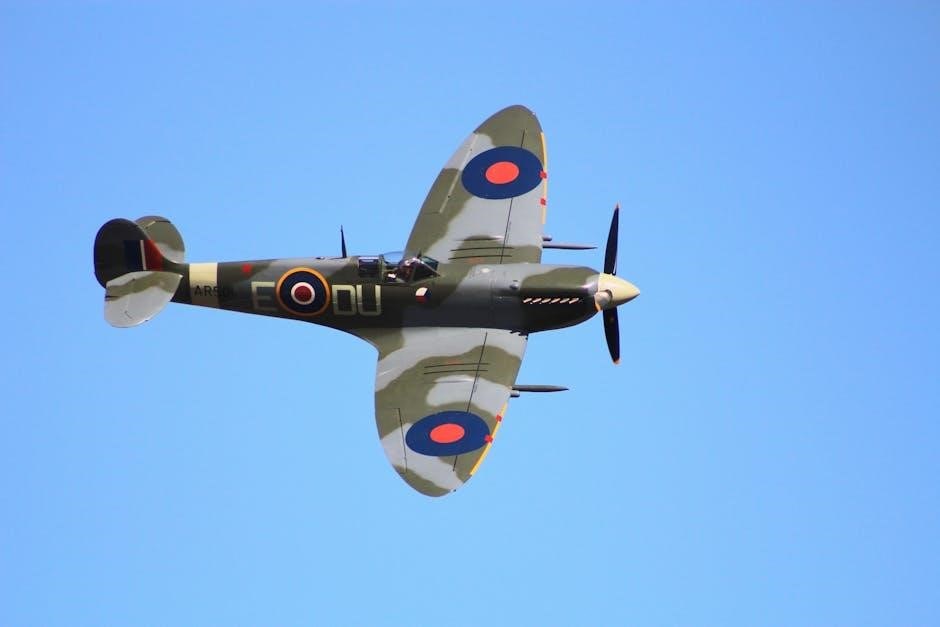
Legacy of WWII Aircraft
WWII aircraft left a lasting impact on aviation‚ influencing post-war designs and technologies. Their historical significance and cultural value are preserved in museums and restoration projects globally.
9.1 Influence on Post-War Aviation
WWII aircraft significantly shaped post-war aviation‚ driving innovations in jet engines‚ radar‚ and aerodynamic designs. The war accelerated technological advancements‚ leading to modern commercial and military aircraft. Lessons learned from WWII aircraft‚ such as durability and efficiency‚ influenced the development of iconic planes like the Boeing 707 and F-16. The era also spurred the creation of advanced materials and systems‚ laying the foundation for today’s aviation industry. The legacy of WWII aircraft continues to inspire aerospace engineering and design.
9.2 Preservation and Museum Exhibits
WWII aircraft are meticulously preserved in museums worldwide‚ offering insights into their historical and technical significance. Detailed manuals and specifications aid restoration efforts‚ ensuring authenticity. Exhibits often feature rare planes like the B-29 Superfortress and Mitsubishi A6M Zero‚ attracting enthusiasts. Interactive displays and educational programs highlight their roles in WWII‚ fostering a deeper understanding of aviation history. These efforts honor the legacy of WWII aircraft while educating future generations about their impact on the war and beyond.
9.3 Cultural and Historical Significance
WWII aircraft hold profound cultural and historical significance‚ symbolizing national pride‚ innovation‚ and sacrifice. Iconic planes like the Supermarine Spitfire and Mitsubishi A6M Zero are celebrated for their roles in shaping the war’s outcome. Their stories are preserved in literature‚ film‚ and museums‚ inspiring generations. These aircraft embody the ingenuity and resilience of their era‚ serving as timeless reminders of the conflict’s impact on global history and human achievement.
9.4 Modern-Day Collecting and Restoration
Enthusiasts and collectors worldwide actively preserve WWII aircraft‚ restoring them to their former glory. Many rare planes are meticulously rebuilt using original specifications and materials‚ often for display in museums or private collections. This dedication ensures historical accuracy and educates future generations about their significance. The process involves extensive research‚ craftsmanship‚ and passion‚ honoring the legacy of these iconic machines and the heroes who flew them during the war.
